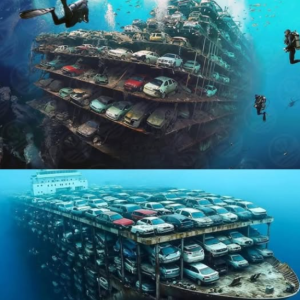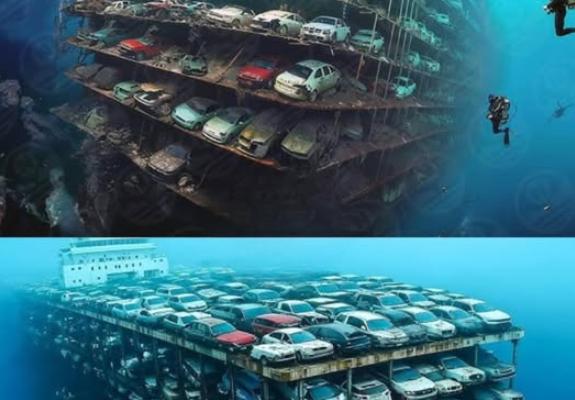BREAKING NEWS!!! Billion-Dollar Inferno — The Luxury Cars Lost to the Atlantic
In a disaster that has left the global auto industry reeling, a cargo ship carrying thousands of high-end luxury cars has been lost to the depths of the Atlantic Ocean after a massive fire turned it into a billion-dollar inferno. The shocking event, which unfolded over several harrowing days, has become one of the most expensive maritime losses in recent memory.
The Start of a Catastrophe
It began as a routine voyage across the Atlantic. The cargo ship — a massive vehicle carrier stretching nearly 650 feet long — departed from the port of Emden, Germany, loaded with some of the most expensive cars in the world: Porsche, Bentley, Lamborghini, Audi, and Volkswagen models destined for customers in the United States.
There were nearly 4,000 luxury vehicles aboard, each worth between $100,000 and $500,000. Together, the total cargo value was estimated at well over $400 million, but when insurance and damage costs are factored in, experts say the overall loss could easily surpass one billion dollars.
But just days into the voyage, disaster struck. Somewhere in the mid-Atlantic, the crew reported smoke rising from one of the cargo decks. Within hours, flames erupted, fueled by the very thing that makes modern vehicles so powerful — their lithium-ion batteries.
A Fire Unlike Any Other
The fire that broke out was no ordinary blaze. Lithium-ion batteries, commonly used in electric and hybrid vehicles, burn at extreme temperatures and are notoriously difficult to extinguish. When one cell catches fire, it can trigger a chain reaction known as “thermal runaway,” spreading rapidly from one battery to the next.
The ship’s crew fought valiantly, activating the vessel’s fire suppression systems, but it was soon clear they were outmatched. Dense, toxic smoke filled the decks as flames tore through the ship’s interior.
Realizing the danger, the captain made the call that would save lives: abandon ship.
A nearby merchant vessel and the Portuguese Navy rushed to the scene, rescuing all 22 crew members. Miraculously, every sailor survived. But the ship — and everything aboard it — was doomed.
The Inferno at Sea
For days, the burning ship drifted helplessly across the Atlantic, smoke billowing into the open sky. Satellite images captured the haunting sight of a vessel smoldering in isolation, flames flickering through the thick haze.
Firefighting tugboats attempted to contain the blaze, spraying seawater over the decks, but they faced a critical dilemma: too much water could destabilize the ship and cause it to sink faster, while too little meant the fire would rage unchecked.
Reports from maritime authorities described temperatures so high that parts of the ship’s steel hull began to warp. Entire decks collapsed as luxury vehicles — once gleaming symbols of wealth and craftsmanship — were reduced to twisted, molten wreckage.
One maritime engineer described the situation bluntly:
“When lithium batteries catch fire in a confined space like that, you’re fighting a furnace. You can’t put it out — you can only wait for it to burn itself down.”
The Final Moments
After nearly two weeks adrift, the inevitable happened. The ship began to list heavily to one side, taking on water as its structure weakened beyond repair. Onlookers from rescue vessels could only watch as the billion-dollar ship slipped beneath the waves, taking with it thousands of luxury dreams.
The exact coordinates of the sinking were recorded by the Portuguese Navy, marking the final resting place of what many are now calling “The Billion-Dollar Graveyard of the Atlantic.”
The Luxury Brands Respond
The loss was not just a maritime tragedy but a massive commercial blow to several of the world’s most prestigious car manufacturers. Porsche confirmed that more than 1,100 of its vehicles were aboard, including special-edition 911s and Taycan electric sports cars. Bentley lost over 180 cars, while Lamborghini reportedly lost an undisclosed number of Aventadors — some of which were among the last of their kind before production ended.
A Porsche spokesperson released a statement:
“We are deeply saddened by the incident. Our immediate concern is for the safety of the crew, who thankfully are all safe. Customers affected by this unfortunate event will be contacted directly, and replacement vehicles will be prioritized.”
Lamborghini echoed the sentiment, though admitted that replacing certain models would be “extremely difficult” due to limited production and custom specifications.
Economic Shockwaves
The sinking sent shockwaves through the insurance and logistics industries. Early estimates placed the insured value of the cargo and ship at nearly $500 million, but analysts say the total economic impact — including replacement costs, delayed shipments, and legal disputes — could easily exceed a billion dollars.
Maritime insurers now face one of the largest vehicle shipping claims in history. Experts also predict stricter safety regulations for transporting electric vehicles across oceans, as lithium-battery fires have become an increasing concern.
Professor Daniel Moreau, a maritime safety specialist, commented:
“This incident is a wake-up call. As more electric vehicles hit the market, we must rethink how they’re shipped. Traditional containment systems simply aren’t enough for battery fires of this scale.”
Environmental Concerns
Beyond financial losses, environmental experts have voiced concern over the ecological consequences of the sinking. The ship carried thousands of gallons of fuel and lubricants, along with heavy metals and chemicals from the burnt vehicles.
While authorities have not reported major oil slicks yet, the long-term impact of submerged batteries and vehicle debris on marine ecosystems remains uncertain. Environmental monitoring teams have been dispatched to track any potential pollution.
A Symbolic Loss
The tragedy has also sparked reflection about the fragility of global trade and consumer excess. Thousands of cars — symbols of luxury, innovation, and human ambition — now lie silent on the ocean floor.
Some commentators have called the event “a poetic irony,” a reminder that even the most valuable possessions can vanish in an instant. As one journalist wrote:
“The Atlantic doesn’t care if it’s swallowing a fishing trawler or a billion dollars’ worth of supercars. To the sea, it’s all the same.”
The Aftermath
Salvage operations are being considered, but experts say retrieving the ship or its cargo would be nearly impossible. The depth of the wreck and the extent of the damage make recovery efforts too costly and dangerous.
Meanwhile, car manufacturers are working tirelessly to remake the lost vehicles, some of which were custom orders placed months or even years in advance. For customers awaiting their dream cars, it’s a bitter reminder that luxury sometimes comes with unexpected delays — and risks.
Conclusion: Lessons from the Deep
The “Billion-Dollar Inferno” stands as a stark reminder of how quickly fortune can sink — literally. In the age of global trade, even the most advanced ships and valuable cargoes remain at the mercy of fire, sea, and fate.




